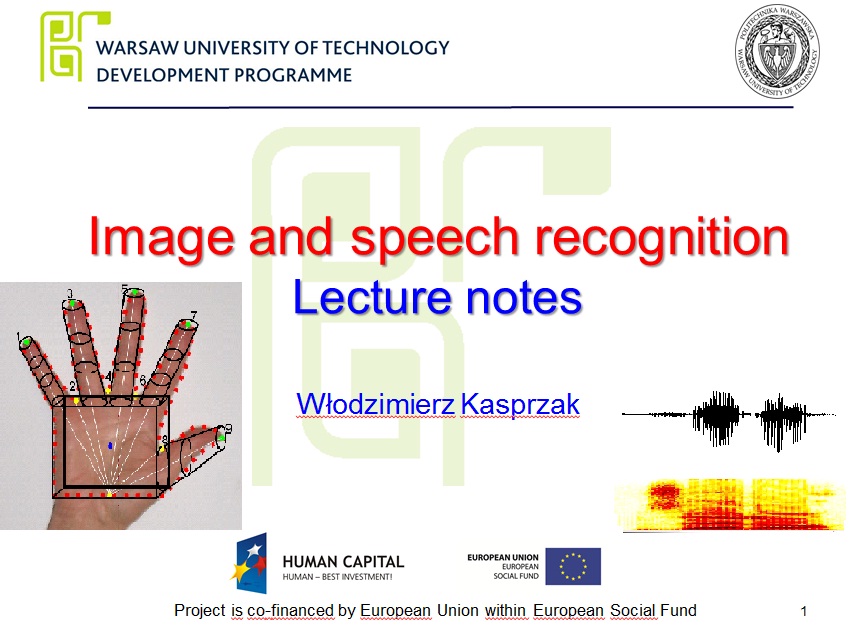
Contents:
Exercises:
Thursday (selected weeks), 12:15-14:00, room 219.
Project:
Thursday (selected weeks), 12:15-14:00, room 219.
Maciej Stefańczyk, M.Sc. (exercises, project)
Office: room 564, E&IT Faculty, Institute of Control and Computation Eng.
Office hours:
Phone: +22 234 xxx
M.Stefanczyk at elka.pw.edu.pl
Prerequisities
Students are expected to have the following background:
Course materials
Lecture notes will be posted periodically on the course web site.
Selected chapters from the books below are recommended as optional reading.

| ECTS Grade | A, 5 | B, 4.5 | C, 4 | D, 3.5 | E, 3 | F/FX, 2 |
| mark | 100- 91 | 90-81 | 80-71 | 70- 61 | 60- 51 | 50 or less |
Lecture and exercise notes, part I: L1, L6, L2, L3
Lecture and exercise notes, part II: L7, L10, L11
[29.11] Test 1 (sections: 1, 2, 3, 6, 7, 10, 11)
Lecture and exercise notes, part III: L8, L4, L5
Lecture and exercise notes, part IV: L12, L8
[17.01] Test 2 (sections 4, 5, 8, 9, 12)
[24.01] Retake test
Suggested Readings
For each lecture section, one or more suggested readings are given below.
| Week | Topic | Readings | Lecture notes |
| (Week 1, 2) | L1. Introduction to pattern recognition. | IASR_B1 | |
| (Week 3) |
L5. Image processing
|
[Kas09, ch.3], [Pitas, 2] [Gonzalez, 2.5, 4.2, 7.3] | IASR_B5 |
| (Week 4, 5) | L2. Pattern transformation | [Kas09, 2.1], [Gonzalez, 3.6], [Duda, 4.10-4.11], [Kas00, 3, 4] | IASR_B2, IASR_B2A |
| (Week 6) |
L9. Speech signal. L10. Phonetics. (cancelled)
|
[Kas09, ch. 7 and 8], [Kas09, ch. 10], [Rabiner, 2.1-2.4], [Rabiner, 3.1-3.2] | IASR_B9, IASR_B10 |
| (Week 7) | L11. Speech features | [Kas09, 9.1-9.2], [Rabiner, 3.3, 4.1-4.6] | IASR_B11 |
| (Week 8) | L6. Image segmentation I | [Kas09, 4.1-4.2], [Pitas, 3], [Gonzalez, 4.3, 4.4, 7.1] | IASR_B6 |
| (Week 9) | Test 1 | ||
| (Week 9, 10) |
L7. Image segmentation II
|
[Kas09, 4.3-4.7], [Pitas, 5-7 ], [Gonzalez, 3.7, 7.2, 7.4, 8,1-8.3] | IASR_B7 |
| (Week 11) |
L3. Pattern classificaton
|
[Kas09, 2.2-2.8, 9.3], [Duda, 2-3, 10] | IASR_B3 |
| (Week 12) |
L4. Pattern sequences
|
[Kas09, ch.5], [Rabiner, 4.7] | IASR_B4 |
| (Week 13) |
L12. Speech recognition
|
[Kas09, 11], [Rabiner, 6] | IASR_B12 |
| (Week 14, 15) |
L8. Object recognition
|
IASR_B8 | |
| (Week 16) | Test 2. |
Goal: The goal of each project work, dedicated for 1-2 persons, is to design a particular analysis system and to implement it as a program application in a programming language (C++, Java, Matlab, C# prefered). The analysis system performs an image or speech recognition task.
Place and time: Friday (selected weeks), 10.15-12.00, room 219.
Schedule:
Suitable implementation tools - libraries with open sources: